More ideas for Lenten meals, this time from Romania. The Sarmale de Post sounds delicious but it's the same as the Serbian sarma I recommended a few days ago.
Romanian cuisine is hearty and heavy in general. However, if you are a vegetarian visiting Romania, you need not worry as there are plenty of Romanian vegetarian dishes for you to enjoy. Romania is a religious country, which means that Lent is still an important time before Christmas and Easter. During this time, religious people do not consume animal products. Sugar is also not allowed as it is considered to be sinful during these periods. Whilst some people will adhere to the fast for religious reasons, others just to reduce the amount of meat they are eating. Because of this, many traditional Romanian meat based dishes are adapted during Lent, making them vegetarian.
Vegetarian food in Romania includes traditional dishes such as sarmale or stuffed peppers. All meat free of course. Because more and more people adapted a vegetarian or vegan lifestyle, restaurants have adapted too and are offering plenty of meat-free options throughout the year.
In this article I have created a guide on vegetarian food in Romania, in which you can see there are plenty of delicious dishes that you can enjoy as someone who doesn’t eat animal meat or products.
Sarmale de Post – Lent Sarmale
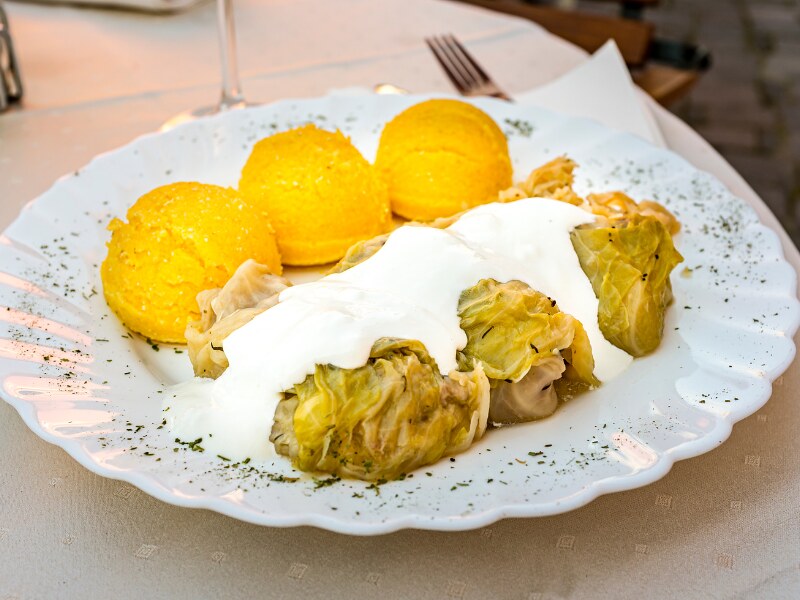
Sarmale is the national dish of Romania. It consists of a delicious meat filling wrapped inside pickled cabbage leaves. However, during the lent, the sarmale are made vegetarian by replacing the minced meat with a mix of chopped mushrooms and rice.
This is one of the most popular Romanian vegetarian foods. Compared to the original recipe, the lent sarmale are much lighter but just as delicious. In summer, these sarmale are usually wrapped inside vine leaves rather than pickled cabbage, which is mostly used during the winter.
Ardei Umpluti de Post – Mushroom and Rice Stuffed Peppers

Another popular vegetarian food in Romania, which is also consumed most often during Lent, are the vegetarian stuffed peppers. Same as in the case of sarmale, the original recipe for stuffed peppers requires pork meat. When it comes to the vegetarian version, the meat is replaced with a mixture of onions, carrots, mushrooms, and rice. The rest of the recipe remains the same, which means that the peppers are cooked inside a tomato broth, and served hot with sour cream.
Cascaval Pane – Fried Cheese
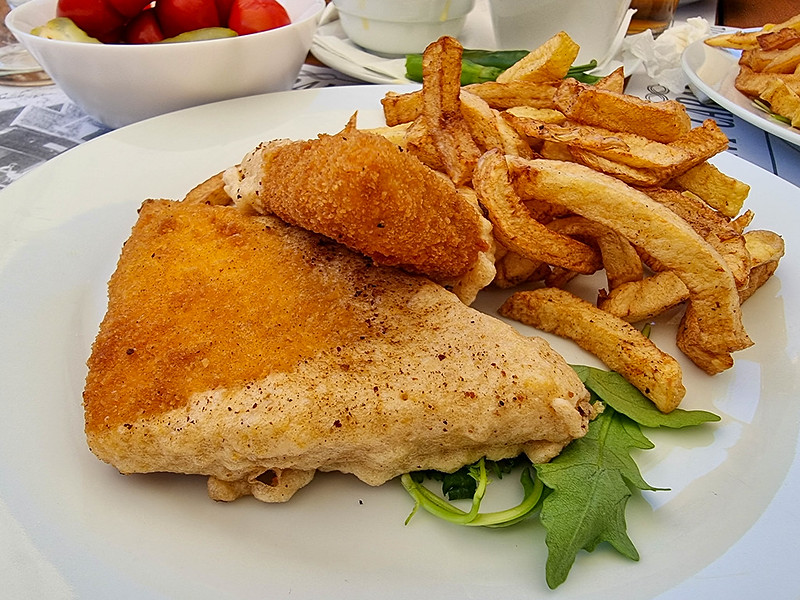
Fried cheese is one of my favourite vegetarian dishes in Romania. It consists of the traditional cascaval cheese, which is hard, rolled though egg and breadcrumbs, and deep fried until the outside becomes crunchy and the interior oozy and decadent.
Cascaval is a traditional Romanian cheese that has the consistency of Cheddar, but with a bit more elasticity. It tastes quite mild. This dish is usually served alongside fries and pickles salad.
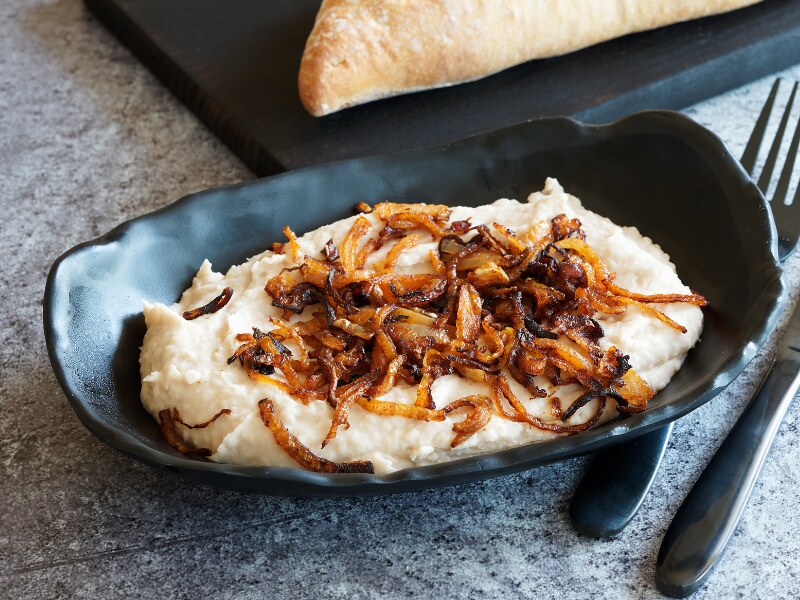
The bean spread is one of the most popular vegetarian appetisers in Romania. It consists of white beans that are cooked and then mashed into a paste, mixed with garlic and paprika. Sometimes, the dip is served with caramelised onions on top.
The best way to eat the bean dip is by spreading it on crusty, rustic bread.
Zacusca – Aubergine and Peppers Spread

Another great classic Romanian vegetarian food is the zacusca. This is a delicious spread that my mother used as a sandwich filling, when I was in school. There are different versions of how this spread is made, sometimes with the addition of mushrooms and even beans. However, the classic recipe asks for grilled aubergines and red peppers. They are slow cooked on an open flame alongside onions, tomatoes and a combination of spices. Zacusca is usually made in the autumn, and preserved in jars for the entire winter. You can also buy jars of zacusca from the supermarket, however it doesn’t taste the same. Mothers always put an extra ingredient in, which is love, as it takes a long time to make zacusca.
Salata de Vinete – Grilled Aubergine Salad
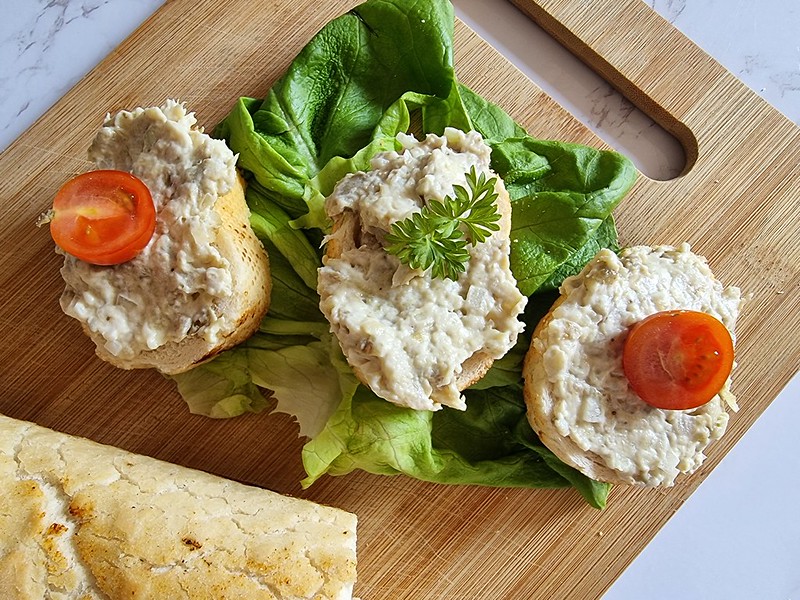
The grilled aubergine salad is one of my favourite traditional Romanian foods. It consists of aubergines which have been roasted on a coal fueled grill, over open flames, until charred. The aubergines are then cleaned, drained, and chopped small. The salad comes alive once the aubergines are mixed with chopped onions, oil and egg yolk, which creates a homemade mayo.
Many traditional restaurants around the country serve the grilled aubergine salad. Once you taste it you will know you’ve made a great decision ordering it.
You can check my recipe for the aubergine salad here.
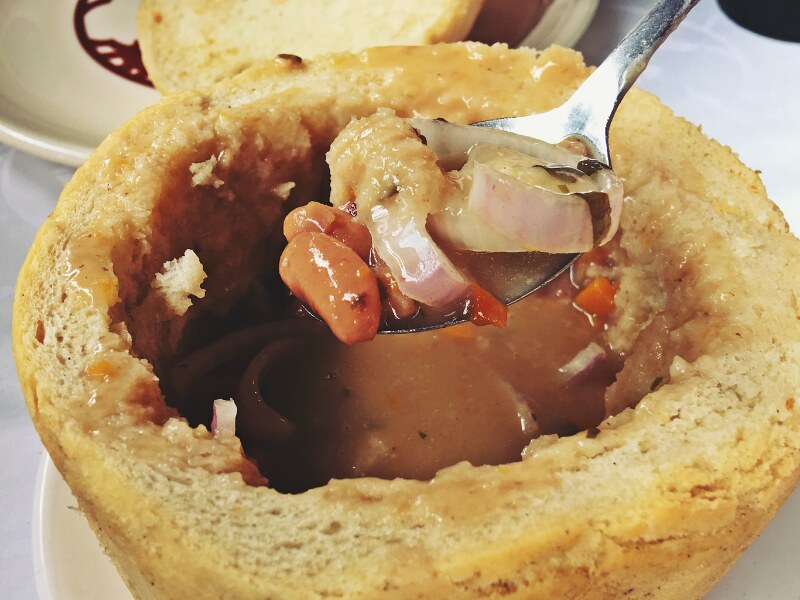
Bean soup is one of the most popular soups in Romania. In restaurants, it is usually served in crusty bread bowls, which makes it an attraction among tourists.
The bean soup is hearty and contains a lot of root vegetables such as turnips, celeriac and onions. It also has many herbs, which give an extra layer of flavour: thyme, lovage, parsley.

All traditional Romanian restaurants will serve vegetable soup. This is a very easy to make ciorba (sour soup), made with a variety of different vegetables, such as onions, carrots, tomatoes, courgettes, cauliflower, potatoes, etc. Each one has its own recipe for the vegetable soup, which can be made with any vegetables that you have lying around the kitchen.
You can check my vegetable soup recipe here.
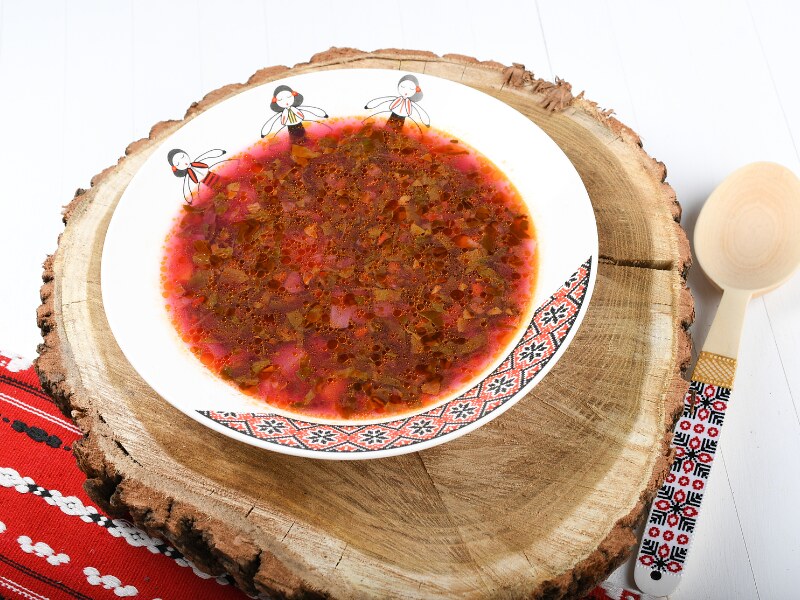
Red orach soup is a very special dish that you can find in Romania only during the springtime. This is when the orach is in season. This is what we call “sour soup”, red because of the colour of the orach. Besides this leaf vegetable, the soup also has carrots, onions, rice and spring onions. The soup is dressed with the traditional bors, as well as eggs, which give it texture.
If you see this soup on the menu of a restaurant, you are in for a treat!
Ciorba de Salata – Salad Soup
Salad soup might sound off, but it’s a great vegetarian dish to have during summer, when the temperatures in Romania are very high. The salad soup can be eaten either hot or cold, and it is very light on the stomach.
The main ingredient in the soup is lettuce, spring onions and wild garlic, as well as paprika and dill. This is a dressed soup, with milk, eggs, sour cream, lemon juice, and flour, which make it very creamy.
Clatite cu Spanac – Spinach Pancakes

I still remember the first time I had the spinach pancakes and their delicious taste that stayed with me until now. My mom tried out a new recipe and whilst I am not a fan of spinach, this vegetarian dish tasted incredible. The spinach is chopped and included in the pancake batter. The pancakes are then filled with a mixture of telemea cheese, garlic, dill, and eggs, and put in a tray to be baked in the oven. Over them is poured a mixture of sour cream and grated cascaval cheese which will create a beautiful tasty crust.
Salata Orientala – Romanian Potato Salad

The Romanian Potato Salad can be a lunch on its own, or a side dish. Whilst it is a very simple dish, it is flavoursome and extremely popular around the country, especially during Lent. Besides the potatoes, this salad also has eggs, red onions, pickles, and black olives.
The Romanian potato salad is dressed with a classic olive oil and vinegar mix, which enhances its flavours creating a delicate balance between sweet and sour.
You can see my Romanian potato salad recipe here.
Salata de Ardei Copti – Grilled Peppers Salad

Grilled peppers salad is a classic at open air barbecues. The peppers are charred over the open fire, before any other ingredient is placed on the grill. Then their skin is taken off and they are soaked in a garlic vinaigrette. It is delicious!
You can see my grilled peppers salad here.

Courgette is a very popular vegetable used in Romanian cuisine. There are quite a few dishes in which the courgette is the main star. One of them is fried courgettes. The vegetable is sliced, salted and dried, until it’s completely dry. The slices are then passed through flour, eggs, and breadcrumbs, before being deep fried in hot oil.
The fried courgette slices are served alongside a yogurt, garlic and dill dip.
Sufleu de Dovlecei – Courgette Souffle
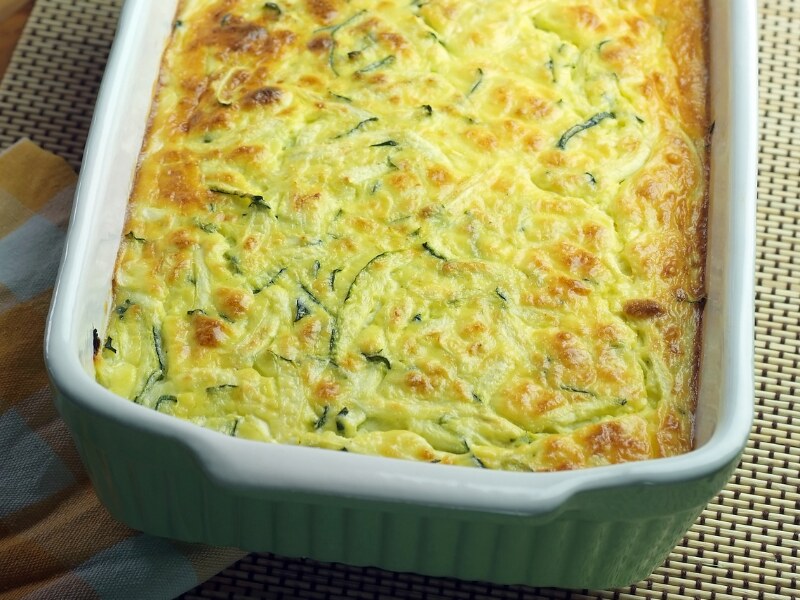
Another fantastic vegetarian recipe using courgettes, is the souffle. The courgette is grated, drained of all liquid, and mixed with a white Mornay sauce. The egg whites are mixed until stuff, then carefully folded into the mixture. Before putting the tray into the oven, the top of the souffle is sprinkled with grated cascaval cheese and slices of butter. The end result is a delicious dish that is usually served with green salad.
Salata a la Russe – Russe Salad
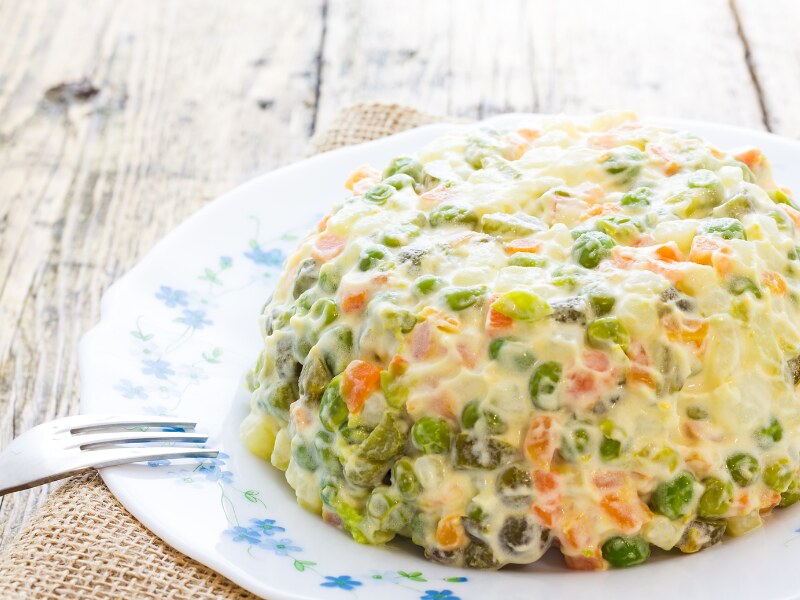
Russe Salad is the vegetarian version of the Beouf Salad, which is one of the traditional Romanian dishes served during holidays such as Christmas or Easter. It is also made during Lent, when many Romanians, especially in the countryside, respect the religious holidays.
It consists of a mix of potatoes, carrots, pickles, eggs, olives, and sometimes peas then, all bound together with mayonnaise.
Pilaf – Vegetable Rice
Pilaf is another vegetarian Romanian dish that can be served as a main meal or as a side dish. It is practically rice with vegetables such as onions, carrots, red peppers, mushrooms and sometimes, tomato sauce. The pilaf has a saucy consistency and it’s not dry, like an Indian rice dish for example. When it is served as a main meal, the pilaf is often accompanied by salad or pickles.
Ghiveci – Vegetables Stew
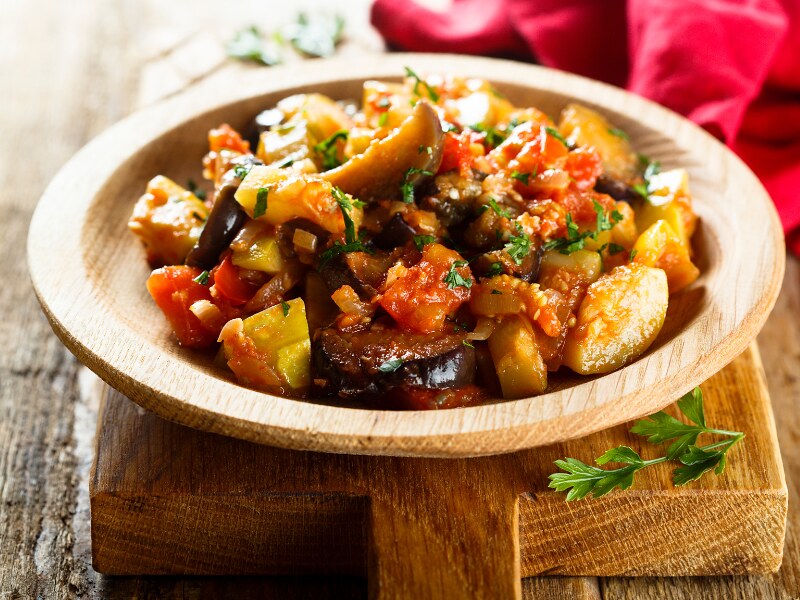
Growing up, I wasn’t a fan of ghiveci. I don’t know why as it is a very flavoursome dish. This dish is a medley of vegetables cooked together in a tomato sauce. It is a versatile dish, easy to customise with whatever vegetables you have lying around: potatoes, cauliflower, leeks, aubergines, carrots, green beans, onions and garlic. Once the liquid has evaporated, it is ready to serve.
Mamaliga cu Branza si Smantana – Polenta With Cheese and Sour Cream
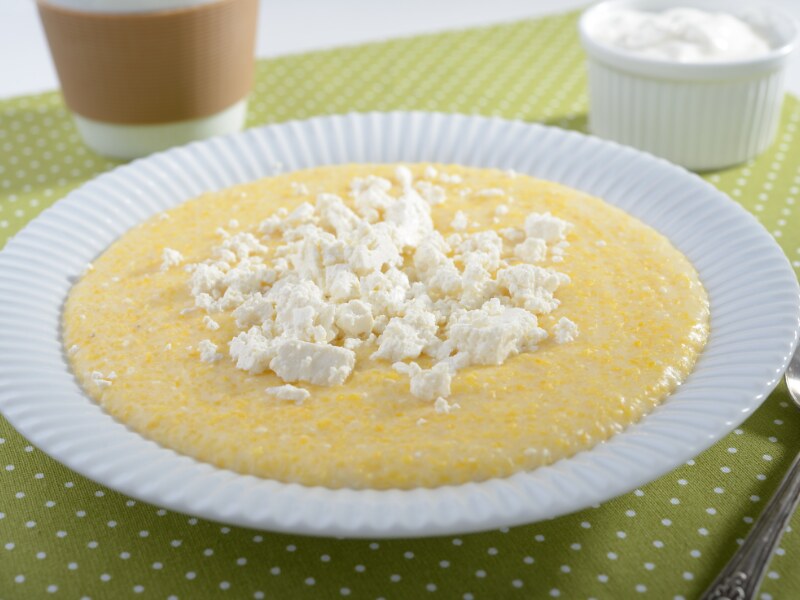
I have always loved polenta with cheese and sour cream. I remember when I was only a few years old and my grandparents took them with me on several spa breaks in Covasna, a thermal water town in Romania. Whilst they would eat a specific diet recommended by the doctor, the hotel would always make me polenta with cheese and sour cream. I loved mixing all together and always asked for more sour cream. The dish is very simple: soft cooked polenta with pieces of butter melting inside it, telemea cheese and dollops of fatty sour cream on top.
Iahnie de Fasole – Baked Beans
Baked beans is a very popular Romanian dish. It is a hearty stew, served mostly in winter. It consists of white beans cooked together with onions, root vegetables, and tomato sauce. They are all slow cooked for a couple of hours, and towards the end, garlic is added. This is a main meal which is served with rustic bread.
Spanac cu Oua – Spinach with Eggs

Spinach with eggs is a light vegetarian dish that is usually made during spring time. Instead of spinach, some people also use nettles when they are in season. The spinach is cooked with garlic, and mixed with sour cream which creates the creamy consistency of the dish. The spinach is then topped with fried sunny side up eggs before serving.
Mancare de Mazare – Peas Stew

Pea stew is another Romanian dish that can be made vegetarian during Lent, by removing the meat. Usually this stew is made with chicken, but the vegetarian version replaces the meat with potato and carrots. I have always liked this stew because it has a slightly sweet taste and it’s a light meal.
Praz cu Masline – Leeks with Olives

Leeks with olives is a classic traditional Romanian recipe for lent. Originating from the south of the country, the leek with olives is a light dish that is very easy and quick to make. Among the ingredients for this dish, besides the leeks and the black olives, are tomatoes, onions, garlic, paprika, white wine and sometimes even red pepper.
This is a dish with plenty of sauce, so make sure to order some crusty bread, for dipping in.

No comments:
Post a Comment
Comments are subject to deletion if they are not germane. I have no problem with a bit of colourful language, but blasphemy or depraved profanity will not be allowed. Attacks on the Catholic Faith will not be tolerated. Comments will be deleted that are republican (Yanks! Note the lower case 'r'!), attacks on the legitimacy of Pope Leo XIV as the Vicar of Christ, the legitimacy of the House of Windsor or of the claims of the Elder Line of the House of France, or attacks on the legitimacy of any of the currently ruling Houses of Europe.